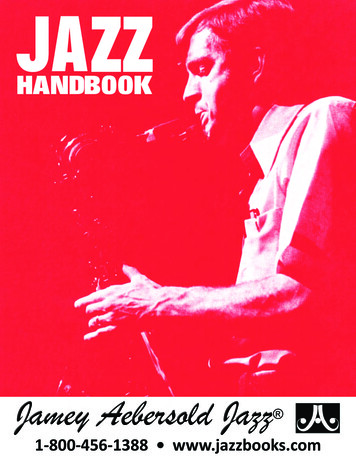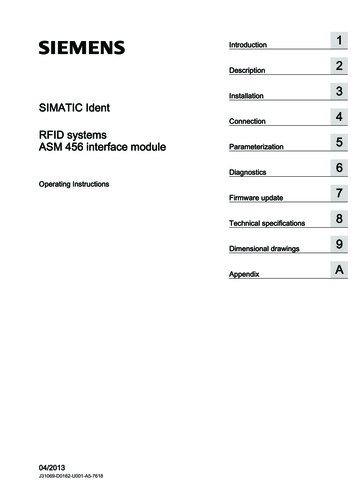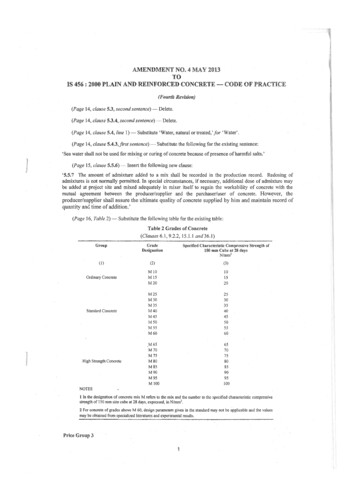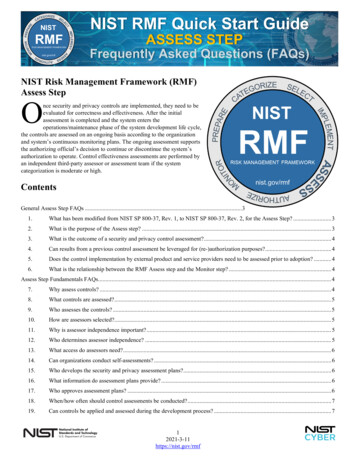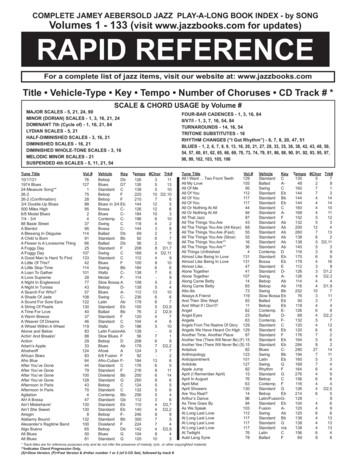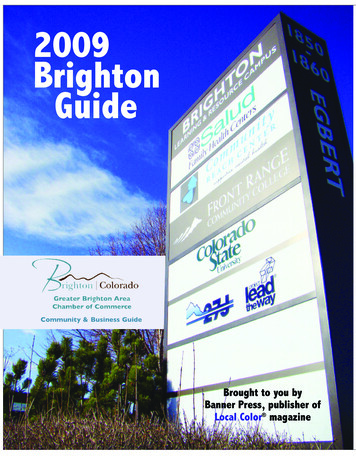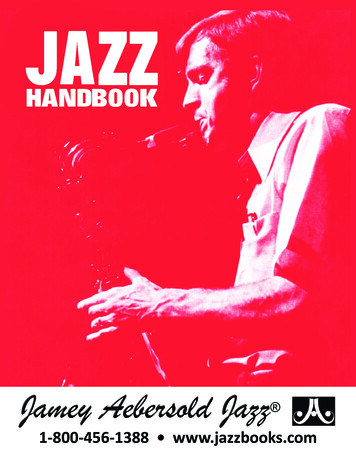
Transcription
1-800-456-1388 www.jazzbooks.com
Cover Photo is Jamey AebersoldCONTENTSGENERAL INFORMATION.2Valuable Jazz Information.3SOLOING by Jamey Aebersold.4Jazz: The Natural Music.5Suggested Listening–Jazz Artists.7Historically Significant Recordings.8Tips For Learning A New Tune.9Practice Procedures For Memorizing Scalesand Chords To Any Song.9Practice Procedures–Musical Examples.10SONG LIST for Beginners.11SCALES.12Introduction to the SCALE SYLLABUS.13SCALE SYLLABUS.14NOMENCLATURE.15The Dominant 7th Tree of Scale Choices.16Ten Basic Exercises–TREBLE CLEF.17Ten Basic Exercises–BASS CLEF.18TREBLE CLEF SCALES.19BASS CLEF SCALES.20Ear Training.21Interval Chart.22Basic Keyboard and the Chromatic Scale.23The Circle of Cycle of Fourths.24Scales/Modes Based on the Major Scale.24HOW TO PRACTICE by Jerry Coker.25HOW TO PRACTICE by David Liebman.25Things That Create Interest When Soloing.26Starting A Phrase or Melody.26Jazz ARTICULATIONS.27Jazz RHYTHMS.29The BLUES SCALE and Its Use.30F BLUES & Bb BLUES PROGRESSIONS:For TREBLE CLEF C Instruments.31For Bb Instruments.31For Eb Instruments.32For BASS CLEF C Instruments.32PLAYING THE BLUES.33What Does “To Hear” Really Mean?.34VARIATIONS ON BLUES.35Values–Plato Quote–Bill Evans Quote.36BEBOP CHARACTERISTICS by David Baker.37Short List of Bebop Players.38BEBOP SCALES.38Transposition Chart.39Two Interesting Short Stories.39Jamey’s JAZZ THEORY ASSIGNMENTS.41II/V7/I Progression With Emphasis On The7th Resolving To The 3rd.46PIANO VOICINGS:Blues Voicings.47Major and Dominant 7th Voicings.48II/V7/I Voicings.49Jamey’s POINTS TO REMEMBER.52This booklet is provided FREE OF CHARGE by Jamey Aebersold Jazz.If you would like a complete catalog of the thousands of jazz educational materials available,please call 1-800-456-1388 or visit www.jazzbooks.comSUMMER JAZZ WORKSHOPSFor information concerning the finest in jazz education write to SUMMER JAZZ WORKSHOPS, c/o the addressbelow. Our week-long Workshops (and the 2-day “Anyone Can Improvise!” Seminars) are held in locationsall over the United States and are open to people of all ages, all abilities and all instruments. You will not finda better program anywhere in the world!Call 1-800-456-1388, or visit our website for the most up-to-date info: www.summerjazzworkshops.comPublished byJAMEY AEBERSOLD JAZZP.O. Box 1244New Albany, IN 47151-1244www.jazzbooks.comCopyright 2000, 2010 by Jamey Aebersold Jazz . All Rights Reserved. Printed in U.S.A.International Copyright secured. All copyrights used by permissionNo portion of this book may be reproduced in any way w/o express written permission.1
GENERAL INFORMATIONThis booklet is designed to give you the basics which you will need in order to learn the art of improvising inmusic. Many feel that people who improvise or play jazz are special. If they are special, it is because they havespent their time wisely learning the tools of the trade. A few of the tools are: scales, chords, patterns, licks, songs(standards and originals), training the ear, listening to records of jazz greats and any other thing which they feelwill contribute to the growth of a well-rounded musician.I feel it is good to establish a practice routine, especially for those of you who are new to learning the languageof jazz. To play jazz requires discipline, and discipline is good for all of us.The language of jazz or the jazz idiom is in a constant state of flux. In order to be a part of the jazz movementone must accept change. Jazz has changed greatly over the past 70 years and is presently in transition. Eachgeneration of jazz musicians contribute their own unique ideas, feelings, and sound to the music and this is whatcreates the change. If you equip yourself well, you may be one of those people who influence others and set newtrends in jazz.If you want to get it all together, I suggest reading each of the pages in this booklet very carefully. Mark with penor pencil points that you feel are important so when you flip through the pages In the future your eye will catchthem. Listen, listen, listen carefully to anyone playing jazz or improvising. You can learn much from live performances as well as records. Start a record collection and listen to what has been recorded over the past 85years. You are in for a treat!Spend your practice time wisely. Don’t play things over and over that you can already play. This is great for theego but does little to advance your musical progress. Be patient with yourself. Don’t expect everything to comeat one setting. They say that things come to us when we are ready to accept them. A healthy mental state is alsoresponsible for progress when practicing.Gradually train your ears to really HEAR music and all of the components that make the final product. Read thepages on Ear Training carefully and institute a daily routine to improve your perception. There are also otherpages that help spell out an excellent practice routine.Since most of us do not have a good rhythm section at our disposal, I recommend practicing and soloing with theplay-a-long records. Each volume contains a book and one or two CDs. Many professionals use these recordingsto warm-up, keep in shape, practice new patterns or licks, or to learn new songs and improvise on the chord/scale progressions.During the past 43 years, many private teachers as well as high school and college teachers have made therecordings part of their daily or weekly teaching assignments. It is good to begin playing with a rhythm section assoon as possible and the better they are the more you can benefit from the experience. I personally still practicewith my Play-A-Longs in order to continue to progress musically.Playing jazz teaches self-esteem and independence.I highly recommend our SUMMER JAZZ WORKSHOPS which are offered in the U.S. each summer. Some of thefinest performers and teachers of jazz appear at these workshops. Write to: Summer Jazz Workshops, P.O. Box1244, New Albany, IN 47151-1244, or visit www.summerjazzworkshops.com for more information.Lastly, play on the best instrument that you can afford and study with the finest teachers available.May your journey in music, and jazz in particular, be as enjoyable as it has been for me in putting this booklettogether for you.2- Jamey Aebersold
VALUABLE JAZZ INFORMATIONThe basic ingredients in music are SCALES, CHORDS, MELODY, RHYTHM, and HARMONY. Jazz education’s purpose is to give you thebasics you need in learning to play jazz or to improvise. The jazz musician is an instant composer! The melodies which come from theirinstruments are conceived in their mind just before they play them. The difference between the improviser and the traditional composer isthis: that the “jazzer” has no eraser to instantly correct mistakes. They practice long and hard trying to make their physical body and theirmental frame of mind an appropriate vehicle to execute the ideas formulated in their mind.The GOAL of every jazz musician is to play on their instrument (or vocally sing) what is heard in their mind. Practicing scales, chords(arpeggios), exercises in all keys will help gain facility which will help unlock the ideas that are now being held prisoner in your mind. Assoon as possible, try playing what you HEAR mentally in your head! In other words, sing a short melody mentally, or sing with your mouth,and then play those exact pitches and rhythms on your instrument. This is the same procedure the jazz player uses when improvising.To play requires discipline. It is good to establish a practice routine. Improvisation should be a part of your daily practice. Play whateveryou hear in your head. It could be something from TV, radio, or just some melodies that you hum to yourself. This is also a form of EARTRAINING. You are training your inner ear to direct your fingers to the notes it hears, instantly. Gradually train your ears to really HEARmusic and all of the components that make the final product. Listen carefully to anyone playing jazz or improvising. You can learn muchfrom live performances as well as recordings. Start a collection and listen to what has been recorded over the past 80 years.The old myth that says, “You either have it or you don’t,” is strictly a myth founded on ignorance and the inability (or unwillingness) of thosewho can play to share what they do verbally with those who think they can’t learn.The mind is the originator of ALL musical thoughts. The mouth (singing) usually can approximate the pitches, rhythms, and nuances ofwhat the mind hears better than actual instruments (sax, trumpet, etc.) can do. Since the instrument we have chosen is a learned device,it is the least able to reproduce the musical thoughts of our mind. It stands to reason that the person who is better equipped technicallywill come closer to playing on their instrument the thoughts of their mind.One of the reasons the jazz greats sound different than you is the fact they have so many sounds (scales, chords, patterns, ideas) attheir disposal. The SCALE SYLLABUS can help you uncover new sounds. Practicing, using the exercises found in this booklet or in Vol.1 “How To Play Jazz And Improvise” will give you a good foundation to play ANY style of music.“JAZZ IS FREEDOM!” Thelonious Monk said this. Too often we refuse to take advantage of an opportunity which will allow us a measureof growth and freedom in our musical expression. Listening to jazz greats is inspirational and rewarding. Keep this in mind: practicingexercises, patterns, licks, scales, and chords should lead to more expressive creativity, not boredom.HOW DO YOU BEGIN IMPROVISING? Many people begin by playing by ear (letting their inner musical ear guide their choice of notesand rhythms). This is a hit-or-miss process that most jazz players (before 1965) had to use to learn their trade. However, this methodstrengthens the player’s ear and is extremely valuable. Everyone should spend time each day playing by ear. The sooner you train yourears to discern, the sooner they can HELP YOU in making music. By using your ear, and knowledge of the needed scales and chords,you will feel much more comfortable with beginning improvisation.IMPORTANT: Don’t get hung up practicing exercises and more exercises without ever attempting to improvise. Avoid becoming a personwho plays great exercises, but delays using their creative energy until tomorrow. DO IT NOW! IMPROVISE. Even if you only use a few notesof the scale, begin there. START! Don’t put it off until tomorrow or until you have the scale under better control. DO IT NOW! The longestjourney begins with a single step. Today is the first day of the rest of your life. The longest musical phrase begins with a single note.Just because you practice scales, chords, patterns, and exercises doesn’t mean you will sound stiff and mechanical, OR that you willbecome a jazz great! But it’s a means to an end. More than any other ingredient, the JAZZ TRADITION is based on LISTENING. Listening to jazz records/tapes should be part of every musicians daily routine. Not only is it fun to listen to, but you can absorb many musicalideas and incorporate them into your own solos. Recorded music contains most answers you seek.Having “good ears” means having the ability to hear the roots to the various chords or scales that are being played; having the ability tohear the quality of the chord or scale--major, minor (what kind of minor?), pentatonic, dim.whole tone, etc.); it means having the ability totell what tone of the scale or chord is being played at any point in the solo--”ah, that note was a #4 resolving to the 6th and then resolvingto the 5th!”; it means hearing the piano, bass, soloist, drums, etc. individually as well as collectively.There are many levels of hearing. Some people hear. Other people can really HEAR! And some can seem to hear and identify almost anything that is being played. They can seem to sing or play back portions of solos right after the performer has played. How can they HEAR,and we can’t seem to find the roots, scale, qualities, or what time signature the piece is in? They have worked hard at identifying all thevarious sounds they hear daily. Since they want to improvise, they take the time to apply on their instrument the things they are hearing.They also use their mind and their free time to figure out things harmonically, melodically, and rhythmically. Using a small chromatic pitchpipe is real helpful in identifying pitches when you are not at a piano or don’t have your instrument. You can carry it with you and train yourear “on the go.” No one knows or could truly imagine the amount of thought each jazzer has put into their art/craft.PRACTICE SUGGESTIONS1. Play with good sound/tone. Wind players -- support your sound. Don’t play staccato.2. Make phrases flow naturally; even when playing scales and exercises.3. Mentally sing the exercises, scales, patterns as you play them.4. If an exercise is hard, slow it down. Then gradually increase the tempo.5. Listen to every note you play. Match your mind’s ideas.6. Be patient. You’re not the first to make mistakes.7. Use jazz articulations on exercises and scale/chord practice.8. Improvise some every day. That’s the REAL YOU. Play what you hear in your head.9. Make a habit of practicing in all twelve keys. Volumes 21 and 24 are excellent.10. Learn the Blues in Bb & F concert keys.11. Memorize everything you can. Know what it is you are trying to play.If we all waited until we were perfect musicians before we played an instrument, there would be no music in the world. Play on the bestinstrument you can afford and study with the finest teachers available who will give you guidance in jazz and traditional music.Use your imagination. Experiment- take chances! You deserve to be creative! Treat yourself.3
SOLOINGby Jamey Aebersold1. Keep your place - don’t get lost. If you do get lost LISTEN to the rhythm section. The drummer will often givea little crash at the beginning of new sections. If you hit a note that is not what you intended, move it up or downa half-step and you’ll probably be back in the scale (or chord). Remember, jazz music usually moves in two, fourand eight bar phrases. You’re never far from a new phrase beginning.2. Play right notes. This really means play the notes you hear in your head . the notes you would sing with yourmouth. Having the scales and chords in front of you on a piece of paper is merely a guide. They don’t provide theactual music that’s going to be played. THAT comes from YOUR imagination. If you’ve got the scales, chords, andchord/scale progression MEMORIZED it provides courage to your imagination and allows you to operate from amore creative natural basis. It allows you to take some chances. It helps remove FEAR.3. Using REPETITION and SEQUENCE is natural in music. It’s found in all types and styles of music. The noviceimprovisor often feels that if they repeat an idea, everyone knows they are going to repeat it, so why do it; plusit’s not original enough for your EGO so you don’t play it. WRONG! The listener needs to hear some repetitionand sequence or else they can’t remember anything you play. Repetition and Sequence are the glue that holdssolos together. The usual number of times something is repeated depends on you but the average is 2 or 3 andthen your mind will tell you when to repeat and/or when to use sequence. It’s a part of the way we hear musicplayed by others.4. CHORD TONES (the 1, 3, 5, & 7 of a scale) are great notes to begin and end a phrase with. Just sing a phraseand see if you don’t follow this simple rule. Our ears HEAR chord tones first so it’s natural to begin and end there.Plus, it gives us and the listener what we’re listening for - harmonic stability.5. SOUND: Be sure that you are getting a good, full sound on your instrument (or voice). Don’t let the scales andchords or the progression or tempo intimidate you. Sound is foremost and is the FIRST thing a person latchesonto when you sing or play. It leaves a lasting impression. So, be yourself and let your voice or instrument ringout. It’s the main ingredient of your musical personality.6. LISTENING: There’s no way anyone is going to play jazz or improvise well without listening to those musicians who have come before. Through listening alone you can find ALL the answers. Each musician is a resultof what they have listened to. It’s easy to determine who people have listened to by listening to them play. Weall tend to use imitation and it’s good to do this. Some feel that if they listen to others they’ll just sound like them.This is not true but your ego will try to convince you it’s true. The ego hates competition or what it perceives to becompetition. Don’t let it fool you. If no one listened to anyone else, why play music? Music is for everyone andtruly is a Universal Language.7. Everyone has the ability to improvise - from the youngest child to the senior citizen. You have to have desireand set aside time to work at it until moving your fingers becomes automatic and the distance between your mindand fingers grows smaller and smaller to where you think an idea and your fingers are already playing it. It’s notmagic. If it is, then magic equals hard work and perseverance. When asked, “What is the greatest obstacle toenlightenment?” the Buddha replied, “Laziness.” I agree!Some of Jamey’s Recommended Play-A-Long Volumes are:1, 24, 3, 21, 116, 84, 54, 70, 47, and 120New Play-A-Long Upgrades -- Slow Tempo CDsVOL. 1VOL. 3VOL. 6VOL. 14VOL. 16VOL. 17VOL. 18Several Play-A-Longs now include a NEW slow tempo CD.4
JAZZ: THE NATURAL MUSICImprovising, playing jazz, is the most natural way to make music. Long before the printing press was inventedpeople played music on various instruments and all were thought to be creative musicians. Through the ages theart of improvising on a musical instrument gradually lost favor to the printed page. In the twentieth century theart of improvising has been kept alive by the jazz musician.Today’s jazzer is not the same as the musician of the thirties, forties or fifties. The influence of jazz education,sound recordings, videos and jazz festivals has allowed the music to reach many more people and to be experienced by almost anyone who is willing to give it a try.For years the myth “you either have it or you don’t” was prevalent in music circles around the world. If you wantedto play jazz you had better get adopted into a musical family or by the “luck of the draw” find the right environmentfor your early years so by osmosis you could pick up on the hot licks and at the same time develop a great jazzear so that when you played your instrument, you would sound like a jazzer.Time has proven that these ideas which were very popular are not true. They never were true but many musiciansthought they were and that’s what gives an idea it’s longevity. Once people from non-musical backgrounds innon-jazzy environments began playing the music and playing it well, everyone had to take another look at whatgoes on when someone stands up and improvises a good solo over a standard chord progression such as GreenDolphin Street, Confirmation, or the blues.Here are several ingredients that go into making a good jazz soloist/improvisor:1. Desire to improvise2. Serious listening to jazz via recordings and live performances3. A method of practice - what and how to practice!4. A rhythm section with which to practice and improvise (via live group or play-a-long recordings)5. Self-esteem, discipline, and determination.When I was a teenager, I wondered if I’d ever be able to play on my instrument the melodies I was hearing in myhead. I didn’t have a jazz teacher so I would listen to the radio or records and try to take off the ideas of the jazzgreats such as Coleman Hawkins, Charlie Parker, Dizzy Gillespie, Sonny Stitt, Chet Baker, Sonny Rollins andmany others. If I were to start again here’s how I would do it:I would begin by playing on my instrument simple little melodies such as Happy Birthday, Twinkle, Twinkle LittleStar, and Row, Row, Row Your Boat. I would pick a note in my middle register say, G, and begin playing one ofthese songs. When I finally played it correctly ONE time, I would pick a new starting note say, Eb and play thesame song beginning on that note. Do this over and over beginning on different tones until you can play the songstarting on different notes without mistakes. Then try a different song and get so you can play it starting on anyof the twelve notes of the chromatic scale. This is an excellent way of conditioning your fingers and mind to worktogether to produce the sounds you are hearing in your head. It shortens the distance from mind to fingers.Jazz musicians have always played the music of their mind—what they hear in their head. They aren’t special,gifted people who were born with more talent than others. They just had more desire and discipline than others.Their ability to mentally hear an idea and then play it comes from practice.When you run out of ideas to practice you listen to other musicians. The joy of listening to others, coupled withyour imagination, will lead to fresh musical ideas. The answer to every musical question may be found on recordings. That is why listening is so important for the beginning improvisor.Usually, we begin improvising on songs like blues in Bb or F, Satin Doll, Maiden Voyage, or Summertime. Songslike these don’t contain tricky rhythms or difficult harmony (scales and chords). This makes it easier to makesense of the song and feel relatively good about improvising over the harmony. These songs (and many more)are on the Vol. 54 “Maiden Voyage” play-a-long.Here are several exercises every professional jazz musician has probably played at one time or another. Playthese over the harmony (changes, chord/scales) to whatever song you are working on. Do this before you tryto improvise.1. Play the first five notes to each chord/scale.2. Play the triad (notes 1,3, and 5 of the scale).3. Play the entire scale from the root (first note) to the 9th and back down.4. Play the 7th chord up and down (1,3,5,7,5,3,1).5. Play the 9th chord up and down (1,3,5,7,9,7,5,3,1).6. Play the scale up to the 9th and then come back down the chord.7. Play the chord up to the 9th and then come back down the scale.8. Play the scale in thirds up and down.5
If you were to take numbers 1, 2, and 3 from above and apply them to the first four bars of an F blues, it wouldlook like this:1.2.3.I once heard trumpeter Woody Shaw warming up before a concert in the above manner. It impressed me becauseI thought only beginners used this type warm-up. After thinking about it, I realized it was the most practical way toapproach any new song. When you do this you are conditioning your mind and fingers to the scales and chordswhich you will in turn improvise over. It makes good sense!You should be able to do this to the chord/scale progression to any song you are going to improvise over. This isstandard practice and has been for some time .know your scales and chords before you play. Memorize them,too! Memorizing melodies, scales and chords gives courage to your imagination.Now, some will feel that to play jazz, you don’t study or practice scales and exercises just play.” I ask, what doesthat mean? Who can “just play” over Giant Steps, Tune Up, Confirmation, Star Eyes, the blues or a thousandother tunes with interesting chord progressions? The famous alto saxophonist Charlie Parker in his own wordssaid there was a period of 3 to 4 years where he practiced 11 to 15 hours a day. If Charlie Parker was, as manysay, a genius, he got that way by practicing. I have a recording of him saying this in an interview with Paul Desmond. I also have a recording of him saying at age 16 (after having gotten laughed off the bandstand for notknowing you’re suppose to play the same song the band is playing!), “I never stopped to think about there beingother keys or nothin’ like that.” So, he began like most of us but eventually discovered that HE was master of hisown ship. He took the bull by the horns and dove into the marvelous world of jazz—the world of improvisation,harmony, rhythm, melody, creativity, imagination and life.If you’ve ever wondered why teachers begin students with fingerings, tone production (wind instruments) andscales, I feel it’s to form a strong foundation for the students’ creativity. Your instrument reflects your musicalpersonality.Transcribing solos or portions of solos off recordings is one of the best ways to find out what the professional isdoing to make things sound so good. By analyzing a solo you can find important facts:1. What note of the scale do they begin phrases with?2. What note of the scale do they end their phrases with?3. Do they use a wide or narrow range, (tessitura)?4. Do they use chord tones in their phrases?5. Do they use scales or bits and pieces of scales?6. Do they have favorite licks that pop up over and over?7. Do they use chromatics (notes outside the basic chord/scale)?8. Do they use passing tones?9. Repetition: do they use it and how .rhythmically, melodically, harmonically?10.Do they use space, rests, silence? How often? Is there a pattern?11.Do they build their solo? Does the solo seem to tell a story or go somewhere?12.Do they tend to place chord tones (1,3,5) on beats 1 and 3 (in 4/4 time).13.Do they incorporate substitute scales over the basic chord/scales?14.Do they double-time any phrases (this usually means playing in 16th notes)?15.Do they use the blues scale? How often?16.Do they use sequences in their playing?Having spent over 50 years working with musicians of all levels, I find that one of the fundamental needs is toexpress themselves in an improvisatory manner on their instrument. Playing jazz has been the route those musicians have taken.Creativity and use of imagination is essential to our well-being as humans on the planet Earth. We are creativebeings. With a little guidance everyone can learn to improvise and enjoy the fruits of self-expression in music.There’s really nothing to be afraid of. Life is exactly what you make it to be.6
SUGGESTED LISTENING - JAZZ ARTISTS1. TRUMPET - Nat Adderley, Louis Armstrong, Chet Baker, Terrance Blanchard, Lester, Bowie, Randy Brecker, Clifford Brown, Don Cherry, Buck Clayton,Johnny Coles, Miles Davis, Kevin Dean, Kenny Dorham, Dave Douglas, Harry Edison, Roy Eldridge, Art Farmer, Dizzy Gillespie, Bobby Hackett, Tim Hagans,Roy Hargrove, Phillip Harper,Tom Harrell, Eddie Henderson, Terumaso Hino, Freddie Hubbard, Ingrid Jensen, Thad Jones, Booker Little, Joe Magnarelli,John McNeil, Wynton Marsalis, John Marshall, Blue Mitchell, Lee Morgan, Fats Navarro, Nicholas Payton, Barry Ries, Wallace Roney, Jim Rotondi, CarlSaunders, Woody Shaw, Bobby Shew, John Swana, Clark Terry, Scott Wendholt, Kenny Wheeler2. SOPRANO SAX - Sidney Bechet, Jane Ira Bloom, John Coltrane, Joe Farrell, Steve Grossman, Christine Jensen, David Liebman, Steve Lacy, ChrisPotter, Wayne Shorter3. ALTO SAX - Cannonball Adderley, Craig Bailey, Gary Bartz, Arthur Blythe, Richie Cole, Ornette Coleman, Steve Coleman, Paul Desmond, Eric Dolphy,Lou Donaldson, Paquito D’Rivera, Kenny Garrett, Herb Geller, Bunky Green, Jimmy Greene, Antonio Hart, John Jenkins, Christine Jensen, Eric Kloss,Lee Konitz, Charlie Mariano, Jackie McLean, Roscoe Mitchell, Frank Morgan, Lanny Morgan, Lennie Niehaus, Greg Osby, Charlie Parker, Art Pepper, BudShank, Steve Slagel, Jim Snidero, James Spaulding, Sonny Stitt, Bobby Watson, Steve Wilson, Phil Woods, John Zorn4. TENOR SAX - George Adams, Eric Alexander, Gene Ammons, Bob Berg, Jerry Bergonzi, Don Braden, Michael Brecker, Gary Campbell, George Coleman, John Coltrane, Junior Cook, Eddie “Lockjaw” Davis, Bill Evans, Joe Farrell, Bud Freeman, Chico Freeman, Von Freeman, George Garzone, StanGetz, Benny Golson, Paul Gonsalves, Dexter Gordon, Johnny Griffin, Steve Grossman, Eddie Harris, Coleman Hawkins, Joe Henderson, Illinois Jacquet,Clifford Jordon, John Klemmer, Ralph Lalama, Harold Land, Pat LaBarbera, Azar Lawrence, Dave Liebman, Charles Lloyd, Joe Lovano, Rick Margitza,Branford Marsalis, Wayne Marsh, Bob Mintzer, Hank Mobley, James Moody, Rich Perry, Billy Pierce, Chris Potter, Dewey Redman, Joshua Redman, SonnyRollins, Pharoah Sanders, Larr
Playing jazz teaches self-esteem and independence. I highly recommend our SUMMER JAZZ WORKSHOPS which are offered in the U.S. each summer. Some of the finest performers and teachers of jazz appear at these workshops. Write to: Summer Jazz Workshops, P.O. Box 1244, New Albany, IN 47151-1244, o
